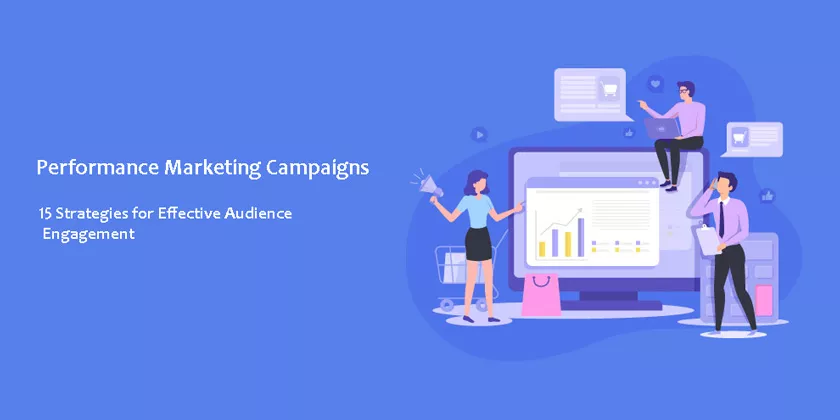The competition for consumer attention is fierce. With many choices available, engaging your audience has never been more important — or challenging.

Performance Marketing Campaigns: 15 Strategies for Effective Audience Engagement
As a brand, you must employ effective performance marketing strategies to engage your audience at multiple touchpoints. Here are fifteen proven performance marketing campaign strategies for driving effective audience engagement.
Know Your Target Audience (Buyer Personas)
Creating buyer personas is not a one-time task but a continuous process. Regularly consult customer surveys, website analytics, and sales data to develop accurate personas.
Even qualitative data, such as customer interviews and testimonials, can be very revealing. The personas you create should detail:
- Demographics (age, gender, income)
- Psychographics (values, concerns, interests)
- Behavioral patterns (online activities, purchasing behaviors).
Spend Some Time Social Listening
Social listening goes beyond just monitoring mentions and comments. You can also track specific hashtags or keywords that pertain to your industry.
This enables you to understand broader trends and sentiments, which may not directly mention your brand but are nonetheless relevant.
Tools like Hootsuite, Mention, or Brandwatch can automate this process, allowing you to react to conversations in real time and adapt your marketing strategies accordingly.
Develop a Strong Brand Voice
Your brand voice encapsulates more than just the words you choose; it includes the imagery, the structures, and even the type of content you publish.
You might opt for vibrant visuals and short, snappy sentences if your brand voice is youthful and energetic.
A more “corporate” voice might entail detailed whitepapers and case studies. Consistency is key; a disjointed brand voice can confuse the audience.
Create Engaging Content
Content comes in many forms: blogs, ebooks, podcasts, infographics, and more. Each content type has advantages and caters to different stages of the buyer’s journey.
For example, blogs and social media posts are great for awareness, while in-depth guides and whitepapers are better suited for the consideration stage. Always offer actionable insights, steps, or takeaways to add value for your audience.
Be Social on Social Media
Interactivity is the cornerstone of social media. Besides posting content, consider hosting live Q&A sessions, creating stories, or developing interactive games or quizzes.
Also, social media algorithms favor content that receives higher engagement, so creating interactive opportunities boosts your visibility on these platforms.
Collaborate With Influencers
Before partnering with influencers, it’s crucial to assess their followers’ engagement levels, not just their follower count. Even influencers with smaller but highly engaged audiences can deliver significant ROI.
Research to see if the influencer has worked with similar brands before, and ensure that their messaging aligns with your brand’s values and goals.
Keep Your Promises
Transparency is paramount. If a product is out of stock or there’s a delay in service, communicate openly with your customers. Also, if you’re collecting customer data, be explicit about how you intend to use it.
Trust is difficult to earn but easy to lose. A single negative experience can lead to bad reviews and customer churn.
Get Personal
Personalization techniques can range from straightforward methods like using the customer’s name in emails to advanced tactics like dynamic content personalization, where website content changes based on user behavior.
Utilizing machine learning algorithms can automate this process, allowing you to provide personalized recommendations similar to what Amazon or Netflix offers.
Tell Engaging Stories With Video
Leverage video formats that align with your audience’s preferences and the platform you’re using. For example, short, snappy videos work well on Instagram, while longer, more detailed videos may better suit YouTube or your website.
Videos can be used for various objectives, from brand storytelling and product showcases to customer testimonials and how-to tutorials.
Surprise Your Audience With Gifts
Loyalty programs or reward points are structured ways to give back to your customers, but sometimes, an unexpected gift can make a greater impact.
These surprises make customers feel valued, whether it’s a limited-time discount code, a small gift included in their next purchase, or even a shout-out on social media. They are likely to boost their lifetime value to your brand.
These strategies can contribute to a more nuanced and effective performance marketing campaign. Combined, they offer a powerful approach to engaging your audience, fostering loyalty, and driving long-term growth.
Optimize for Mobile Experience
With most internet users accessing websites via mobile devices, ensuring a seamless mobile experience is crucial. This extends from website design to the checkout process. A poor mobile experience can dissuade potential customers and lead to decreased engagement.
Leverage Data Analytics
Data analytics tools can offer you deep insights into user behavior. You can understand which channels are most effective, what content resonates with your audience, and even what time of the day they’re most active. This data can inform your strategies and allow for more targeted engagement efforts.
Use Chatbots for Immediate Engagement
Chatbots can handle various tasks, from answering frequently asked questions to guiding users through a purchase. Immediate responses from chatbots can significantly improve user engagement and satisfaction.
Leverage Retargeting Campaigns
Not every visitor will convert on their first visit. Retargeting campaigns allow you to re-engage those who have interacted with your brand but haven’t taken the desired action, like purchasing or signing up for a newsletter.
Test and Optimize
Never assume that you’ve completely figured out your audience. Consumer behavior changes over time, influenced by various factors such as trends, seasons, and economic conditions. Regularly run A/B tests on your campaigns to see what works best and be prepared to adapt your strategies.
Conclusion
Effective audience engagement is not achieved overnight. It’s a continuous process of understanding your audience, delivering value, and building trust.
By employing these ten strategies, you’ll be well on your way to crafting a performance marketing campaign that captures and retains consumer attention.
Remember, the goal of performance marketing is not just to make a sale but to build a relationship. Once you engage your audience, they become consumers and advocates for your brand.
